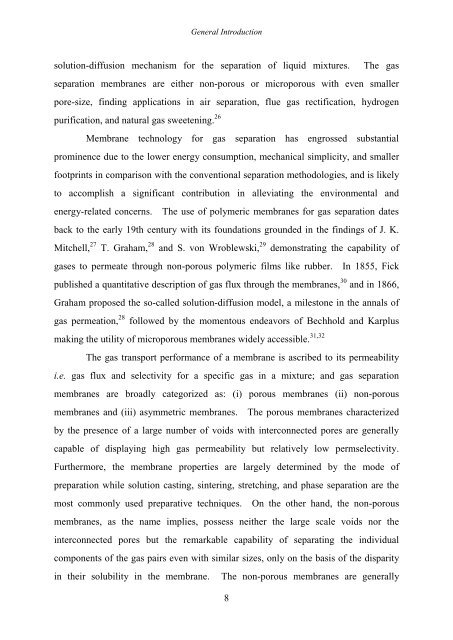Synthesis, Characterization, and Gas Permeation Properties
Synthesis, Characterization, and Gas Permeation Properties
Synthesis, Characterization, and Gas Permeation Properties
Create successful ePaper yourself
Turn your PDF publications into a flip-book with our unique Google optimized e-Paper software.
General Introduction<br />
solution-diffusion mechanism for the separation of liquid mixtures. The gas<br />
separation membranes are either non-porous or microporous with even smaller<br />
pore-size, finding applications in air separation, flue gas rectification, hydrogen<br />
purification, <strong>and</strong> natural gas sweetening. 26<br />
Membrane technology for gas separation has engrossed substantial<br />
prominence due to the lower energy consumption, mechanical simplicity, <strong>and</strong> smaller<br />
footprints in comparison with the conventional separation methodologies, <strong>and</strong> is likely<br />
to accomplish a significant contribution in alleviating the environmental <strong>and</strong><br />
energy-related concerns. The use of polymeric membranes for gas separation dates<br />
back to the early 19th century with its foundations grounded in the findings of J. K.<br />
Mitchell, 27 T. Graham, 28 <strong>and</strong> S. von Wroblewski, 29 demonstrating the capability of<br />
gases to permeate through non-porous polymeric films like rubber. In 1855, Fick<br />
published a quantitative description of gas flux through the membranes, 30 <strong>and</strong> in 1866,<br />
Graham proposed the so-called solution-diffusion model, a milestone in the annals of<br />
gas permeation, 28 followed by the momentous endeavors of Bechhold <strong>and</strong> Karplus<br />
making the utility of microporous membranes widely accessible. 31,32<br />
The gas transport performance of a membrane is ascribed to its permeability<br />
i.e. gas flux <strong>and</strong> selectivity for a specific gas in a mixture; <strong>and</strong> gas separation<br />
membranes are broadly categorized as: (i) porous membranes (ii) non-porous<br />
membranes <strong>and</strong> (iii) asymmetric membranes. The porous membranes characterized<br />
by the presence of a large number of voids with interconnected pores are generally<br />
capable of displaying high gas permeability but relatively low permselectivity.<br />
Furthermore, the membrane properties are largely determined by the mode of<br />
preparation while solution casting, sintering, stretching, <strong>and</strong> phase separation are the<br />
most commonly used preparative techniques. On the other h<strong>and</strong>, the non-porous<br />
membranes, as the name implies, possess neither the large scale voids nor the<br />
interconnected pores but the remarkable capability of separating the individual<br />
components of the gas pairs even with similar sizes, only on the basis of the disparity<br />
in their solubility in the membrane. The non-porous membranes are generally<br />
8

















